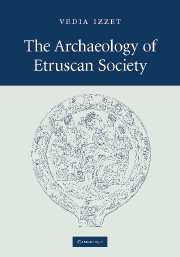Book contents
- Frontmatter
- Contents
- List of illustrations
- Acknowledgements
- List of abbreviations
- Introduction
- 1 Models of change in Etruria
- 2 Etruscan mirrors: reflections on personal and gender identity
- 3 Funerary architecture: the living and the dead
- 4 Sanctuaries: the sacred and the profane
- 5 Domestic architecture: public and private
- 6 Urban form and the concept of the city
- 7 Making Etruscan society: culture contact and (material) culture change
- Bibliography
- Index
2 - Etruscan mirrors: reflections on personal and gender identity
Published online by Cambridge University Press: 10 May 2010
- Frontmatter
- Contents
- List of illustrations
- Acknowledgements
- List of abbreviations
- Introduction
- 1 Models of change in Etruria
- 2 Etruscan mirrors: reflections on personal and gender identity
- 3 Funerary architecture: the living and the dead
- 4 Sanctuaries: the sacred and the profane
- 5 Domestic architecture: public and private
- 6 Urban form and the concept of the city
- 7 Making Etruscan society: culture contact and (material) culture change
- Bibliography
- Index
Summary
Introduction
In this chapter, the corpus of Etruscan bronze hand mirrors will be used in an investigation of the treatment of the surface of Etruscan bodies. It has two aims: the first is to examine the cultural function of mirrors, or as Serra Ridgway puts it, to look at ‘mirrors as objects not just “pictures”’ (Serra Ridgway 1992: 282). As will be shown, the sudden appearance of mirrors in the archaeological record is closely linked to the function of the mirror in adornment. Adornment, or the manipulation of the surface of the body, is a process that is always bounded by the parameters of social and cultural expectations, and is an essential part of the creation of self-identity. The second aim is to look at the variations in such social and cultural expectations between male and female bodies. This is derived from the images of men and women depicted on the mirrors themselves.
Though the earliest recorded find of an Etruscan hand mirror was in 1507 from a tomb near Castellina in Chianti, it was not until the seventeenth and eighteenth centuries that interest in them became significant. At this time, they were called paterae, and were thought to have been used in the pouring of libations. It was not until 1824, when Inghirami published his Monumenti Etruschi, that they were identified as mirrors.
- Type
- Chapter
- Information
- The Archaeology of Etruscan Society , pp. 43 - 86Publisher: Cambridge University PressPrint publication year: 2007
- 1
- Cited by



